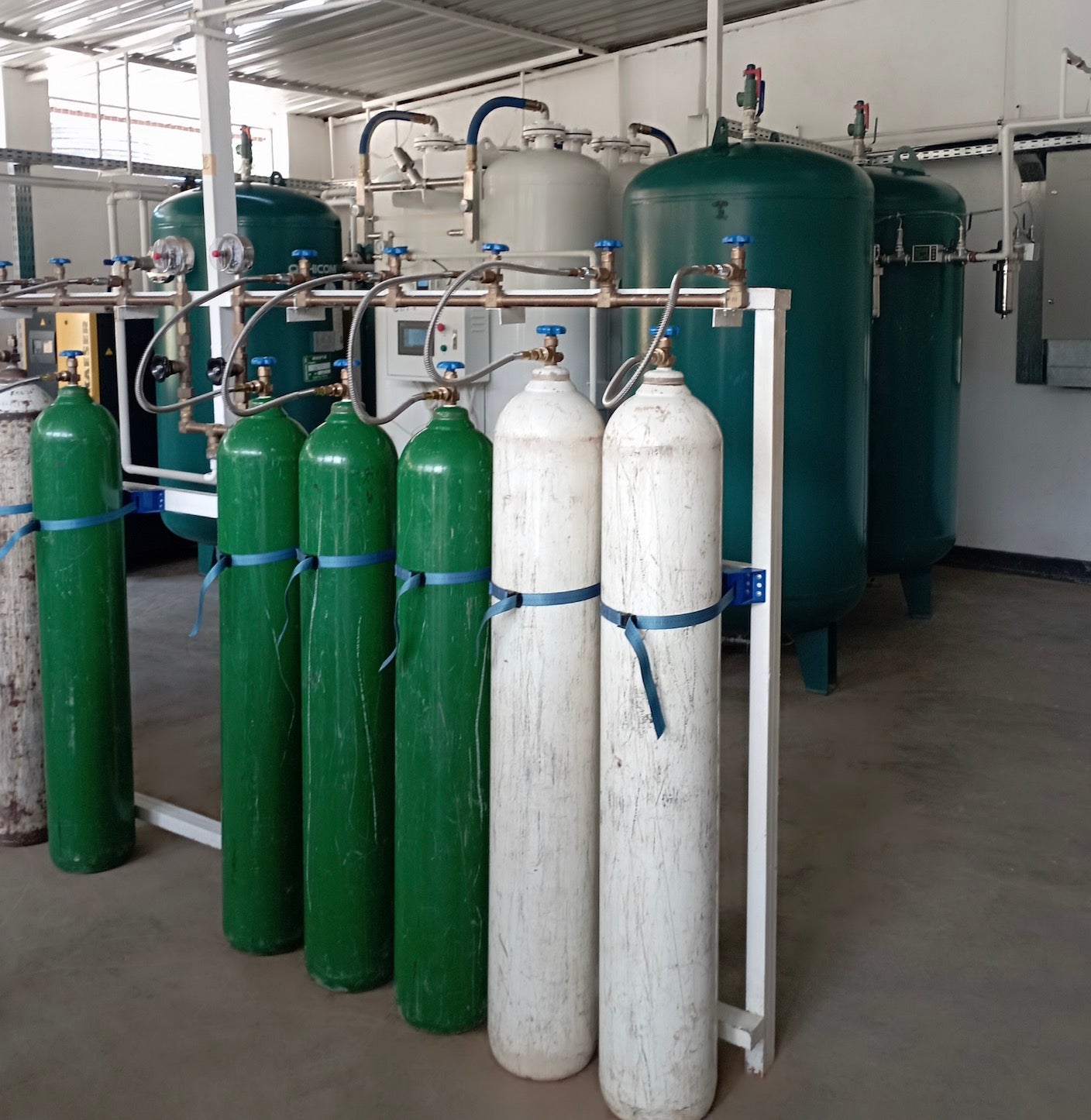 Checking the Intensive Care Unit’s oxygen readiness at Kibuye Referral Hospital, Rwanda, October 2022. Photo: Nataliya De Francisco Serpa/World Bank
Checking the Intensive Care Unit’s oxygen readiness at Kibuye Referral Hospital, Rwanda, October 2022. Photo: Nataliya De Francisco Serpa/World Bank
When Rwanda followed its first COVID-19 case with a countrywide lockdown in March 2020, it was hard to believe that a global health challenge would turn into a trigger for addressing other issues essential to basic healthcare. But, alongside high COVID vaccination rates since, Rwanda’s national response strategy to the pandemic has greatly increased the provision of oxygen to its health facilities.
Medical oxygen is central to treatment in neonatal, intensive care, and surgical units. COVID-19 added new challenges to its importance. This essential commodity became a determining factor in the response to the pandemic and the survival of the population. Intensive Care Units (ICU) were in high demand, needed by patients with acute respiratory failure, dependent on breathing machines.
Figure 1. Daily Confirmed COVID-19 Cases and Need for Medical Oxygen for COVID-19 in Rwanda, Historic pick of July–August 2021 and January 2022
Source: Data on daily cases in Rwanda, Johns Hopkins University. Oxygen needs data.
At the onset of the pandemic, 35% of the hospitals in Rwanda with one or more units requiring a piped oxygen supply—surgical, neonatal, maternity, or pediatric—had one. As the incidence of COVID-19 progressed, reaching a peak of 1,397 confirmed cases in the country on July 23, 2021, so did Rwanda’s oxygen needs (Figure 1). In that critical period, the volume of oxygen produced by Rwanda’s seven operational plants, all of them public, was, at 16,750 liters a day (with 335 cylinders of 50 liters each), well below the country’s estimated needs of over 125,000 liters (2,500 cylinders.) See further information in the Rwanda Plan to Increase Access to Medical Oxygen, July 23, 2020, Republic of Rwanda Ministry of Health - Rwanda Biomedical Center.
The crucial role of oxygen in hospital care
Rwanda faced a medical oxygen supply shortage. The government’s initial response put a strong emphasis on protecting Essential Health Services, with more support for maternal, newborn, and child health. Thus, key elements of its strategy included increasing the production, installing oxygen piping, equipment, and supplies for emergency and essential health services in selected hospitals. The strategy had three phases: acquiring oxygen plants to increase the production capacity, 22 hospitals were to be fitted for piped oxygen in phase one since completed, and 26 in phase two (where the piping process is still underway).
Rwanda intends to boost domestic oxygen production as part of a plan to develop its own biotech/ medtech hub. Its inspiration is Medicon Valley, one of the world’s largest life-sciences cluster, located in Denmark and Sweden. Different partners are willing to support efforts towards this initiative, including the World Bank; the Global Financing Facility for Women, Children and Adolescents; USAID; Global Fund to Fight AIDS, Tuberculosis and Malaria or Global Fund; and the Clinton Health Access Initiative.
Rwanda’s Biomedical Center of the Ministry of Health has installed 26 new Pressure Swing Absorption (PSA) plants—PSA oxygen generating plants are a source of medical-grade oxygen—in strategic locations around the country. These are now producing oxygen for its main provincial hospitals, which often serve as referral hospitals, as well as for surrounding health facilities, reached through a cylinder distribution hub. These PSA plants have the capacity to produce between 5 and 40 cubic meters of oxygen an hour.
This has increased Rwanda’s oxygen daily production from 115Nm3 in 2020 to 546Nm3 in 2022. Its new capacity for producing about 2,500 oxygen cylinders of 50 liters each per day—or 125,000 liters of concentrated oxygen—is equivalent to an increase of more than 600% since 2020. Hospitals in each of the country’s 30 districts are gradually upgrading their oxygen piping systems or installing new ones, with these measures accompanied by upgrades to back-up power and by increased staffing capacity to allow oxygen to be delivered safely and directly to hospitals from PSA plants.
With the aim of equipping itself with a state-of-the-art facility to handle Emerging Infectious Diseases of great public health concern, Rwanda established a “mobile field hospital” in the vicinity of Nyamata District Hospital in Bugesera District in its Eastern Province in February 2022. The facility is currently serving as the national COVID-19 isolation and treatment center for severe COVID cases. It is equipped with an oxygen plant and 100 beds—68 hospital beds and 22 critical care beds. The World Bank has approved funding to power the facility with solar energy as part of COVID operations to support an uninterrupted supply of electricity for the production, distribution, and use of medical oxygen, as well as providing power supply to the field hospital operations when the grid is offline.
Post-COVID-19 recovery
Currently, Rwanda is producing over 2,500 oxygen cylinders (of 50 liters each) a day, a volume exceeding its actual demand in peacetime of 1,000 to 1,500 oxygen cylinders. The volumes of oxygen currently being piped can provide every patient access to oxygen in all the hospital units in the country—maternity and neonatology, accident and emergency, pediatrics, surgery, internal medicine, operating theatres, ICU, and isolation rooms.
The government is fully in charge of the 26 PSA oxygen production plants as part of the second phase of its national strategy to strengthen the healthcare system for respiratory care. Its next step is to develop a strategy to efficiently distribute oxygen to healthcare facilities that don’t have PSA plants and to introduce oxygen therapy at primary healthcare levels, which would enable the provision of acute respiratory care at an early stage. It is also planning to establish back-up storage of oxygen as a national reserve for any future crisis.
Rwanda’s oxygen production roadmap, implemented as part of its COVID-19 response strategy, is a good example of how a country can capitalize on a crisis and come up with novel solutions to create a vision of a stronger, more resilient health system. This vision has not only contributed to tackling the oxygen shortage created by the pandemic but also to meet future demand for oxygen thereby ensuring safe access to critical care in public healthcare facilities.








Join the Conversation